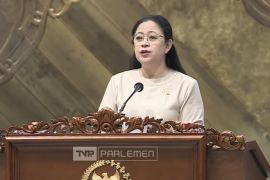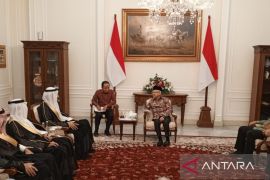"We are going to review it in the monthly board of governors meeting, as we are indeed surprised with the rather high inflation, Agus Martowardojo said.Jakarta (ANTARA News) - Bank Indonesia (BI) Governor Agus Martowardojo has ordered a review of the current inflation hike and the implementation of policies necessary to keep the inflation rate in line with the central bank's target.
"We are going to review it in the monthly board of governors meeting, as we are indeed surprised with the rather high inflation. We already had an idea about the volatility in food prices, but it looks like education costs also increased," Agus said before attending the Cabinet meeting at the Presidential Office on Friday.
He stated that Indonesia did not encourage either, because of the low export value of products from the two sectors. Therefore, Agus urged the government to take immediate steps, through amendments to the 2014 Budget proposal, in order to keep imports in check.
"The changes should also stimulate exports and help provide access to new markets. We realize that India and China have undergone economic corrections. And we export heavily to China. The government is also expected to cooperate with local governments in order to increase foreign direct investment, which directly impacts economic growth," he said.
Indonesia still hopes to achieve better economic growth this year, Agus continued.
"It seems like the latest hike in inflation has hampered domestic consumption," he added.
Earlier, the National Statistics Agency (BPS) recorded Indonesia's year-on-year (YoY) economic growth for the second quarter of 2013 at 5.81 percent.
"The economy increased by 5.81 percent from the same period last year," BPS head Suryamin said here on Friday.
Suryamin explained that the Indonesian economy, measured by gross domestic product (GDP) at current prices, for the second quarter of 2013, reached Rp2,210.1 trillion.
"The GDP at constant prices in the year 2000 reached Rp688.9 trillion," he noted.
Suryamin said the highest YoY growth was reached by the transport and communications sector, at 11.46 percent, while the finance, real estate, and business services sector reached 8.07 percent, and the construction sector reached 6.88 percent.
"The communication sector saw rapid growth in the number of subscribers, compared with the same period last year," he pointed out.
Positive growth was also seen in some other sectors, such as the electric, gas, and clean water services sector (6.6 percent), the trade, hotel and restaurant services sector (6.47 percent), the processing industry (5.84 percent), the services sector (4.48 percent), and the agriculture, livestock, forestry and fishing sector (3.2 percent).
"Only the mining and quarrying sector saw a decline of 1.19 percent in the second quarter, compared with last year, due to reduced production," Suryamin explained.
The 5.81 percent YoY growth was driven by an increase in household consumption expenditure (5.06 percent), government consumption (2.13 percent), gross fixed capital formation (4.67 percent), exports (4.78 percent), and imports (0.62 percent).
Meanwhile, the GDP structure, based on the expenditure dominated by the household consumption expenditure, grew 55.44 percent, followed by GFCF (32.68 percent), government consumption (8.63 percent), exports (23.15 percent), and imports (25.72 percent).
Suryamin added that the biggest contributors to the 5.81 percent economic growth were the trade, hotel and restaurant sector (1.17 percent), the transport and communication sector (1.14 percent), and the processing industry (1.48 percent).
These sectors were followed by the finance, real estate and business services sector (0.78 percent), construction (0.44 percent), services (0.42 percent), agriculture, livestock, forestry and fishery (0.42 percent), electric, gas and clean water (0.05 percent), and, lastly, the mining and quarrying sector (0.09 percent).
Suryamin stated that Indonesia's spatial economic structure during the second quarter of 2013 was still dominated by the Java provinces group, which contributed 58.15 percent to the GDP, followed by Sumatera (23.9 percent), Kalimantan (8.73 percent) and Sulawesi (4.81 percent).
"And the rest was contributed by the other islands, Maluku and Papua, with 4.41 percent," he said.
Thus, the cumulative growth in the nation's economy for the first half of this year reached 5.92 percent, while the growth target set in the 2013 Budget Change is 6.3 percent.(*)
Editor: Heru Purwanto
Copyright © ANTARA 2013











